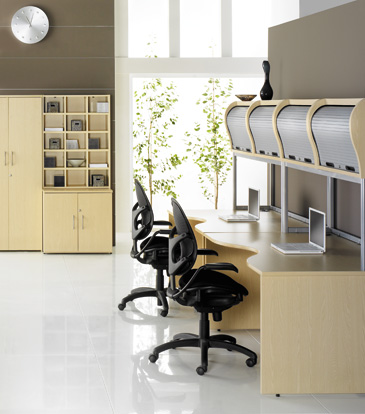Are you tired of the traditional office setup and looking for a change? Hot desking might just be the solution you need. In this article, we will explore whether hot desking makes a better workplace by examining its benefits, drawbacks, and impact on employee well-being and productivity.

What Is Hot Desking?
Hot desking is an office design technique in which employees are not assigned seating. Whilst in traditional offices employees might have assigned cubicles or desks, hot desking allows them to move freely around the office space.
Hot desking offers numerous benefits that can enhance collaboration in a shared workspace. By eliminating assigned seating arrangements, employees are encouraged to interact with colleagues from different departments or teams. This promotes cross-functional communication and fosters a sense of community within the organisation.
Additionally, the flexibility and autonomy provided by hot desking allow individuals to choose their preferred working area based on their tasks or personal preferences. This dynamic approach not only encourages creativity but also enables employees to feel empowered and engaged in their work.
Benefits of Collaboration in a Shared Workspace
Imagine yourself sitting in a vibrant shared workspace, where you can easily bounce ideas off your colleagues and cultivate a collaborative environment that fuels creativity. Hot desking promotes collaboration by breaking down the barriers of traditional office setups.
With hot desking, you have the opportunity to work alongside individuals from different teams and departments, fostering cross-functional collaboration and knowledge sharing. This allows for a diverse range of perspectives and expertise to be brought to the table, leading to more innovative solutions and better decision-making.
In a shared workspace, there is an inherent sense of community that encourages collaboration. The open layout and casual atmosphere make it easy to strike up conversations with your coworkers, creating opportunities for spontaneous brainstorming sessions or impromptu collaborations.
Additionally, hot desking eliminates the hierarchical structure often found in traditional office spaces, levelling the playing field and making it easier for everyone to contribute their ideas without feeling intimidated. Collaboration becomes second nature in this type of environment as people are encouraged to connect, communicate, and collaborate with one another on a regular basis.
Flexibility and Autonomy in Hot Desking
With increased flexibility and autonomy, you can choose your own workspace in a hot desking environment. Unlike traditional offices where you have a designated desk, hot desking allows you to pick the spot that suits your needs on any given day.
Whether you prefer a quiet corner or cubicle for focused work or a collaborative area for brainstorming sessions, the choice is yours. This freedom to select your workspace not only promotes productivity but also enhances creativity as it gives you the opportunity to find an environment that inspires and motivates you.
Furthermore, hot desking provides individuals with the autonomy to manage their own time and schedule. You have the flexibility to arrive and leave at different times without worrying about being tied down to a specific desk or office. This level of independence allows you to work according to your most productive hours, whether that's early in the morning or late at night.
Moreover, with hot desking, you can easily adapt to your surroundings based on your personal preferences. If you need a change of scenery or want a break from sitting all day, you can move around and try different workstations throughout the day. This variety not only helps prevent monotony but also enables individuals to experiment with different setups that optimise their workflow.
The Cost-Effectiveness of Hot Desking for Companies
Save money for your company by implementing hot desking, as it allows for efficient space utilisation and reduces the need for individual workstations.
With hot desking, employees don't have assigned desks but instead choose a desk that's available when they arrive at the office. This means that multiple employees can use the same desk throughout the day, maximising the usage of the workspace.
By eliminating the need for individual workstations for each employee, companies can significantly reduce their real estate costs.
In addition to saving on space, hot desking also reduces other expenses associated with individual workstations. Companies no longer need to invest in expensive furniture and equipment for each employee's desk. Instead, they can provide shared resources such as printers, scanners, and phone systems that are readily available to all employees.
This not only saves money upfront but also reduces maintenance and replacement costs in the long run. Overall, embracing hot desking can be a cost-effective solution for companies looking to optimise their workspace utilisation and save on operational expenses.
Negative Effects of Hot Desking on Employee Well-being
The constant lack of personal space and the inability to establish a sense of ownership can negatively impact employee well-being in hot desking environments. When employees are constantly moving from one desk to another, they never truly have a space that feels like their own. This can lead to feelings of instability and a lack of control over their work environment.
This can also affect their overall satisfaction and productivity. Moreover, the constant noise and distractions that come with hot desking can take a toll on employee well-being. In an open office setting where everyone is working in close proximity, it becomes difficult to concentrate on tasks and maintain focus. The lack of privacy can be particularly challenging for introverted employees who thrive in quiet spaces.
Additionally, the constant movement and interaction with different colleagues can be mentally exhausting for some individuals who need time alone to recharge. All these factors contribute to increased stress levels and reduced job satisfaction among employees in hot desking environments.
While hot desking may offer cost-saving benefits for companies, it comes at the expense of employee well-being. It's essential for organisations implementing hot desking policies to consider these potential drawbacks and provide alternative solutions or support systems that prioritise employee well-being in order to create a better workplace environment overall.
